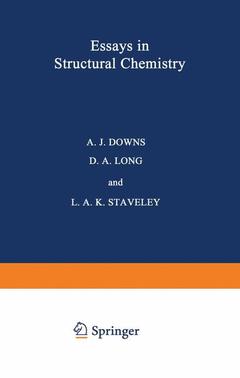Essays in Structural Chemistry, 1971
Langue : Anglais
Coordonnateur : Downs A. J.

This book deals with selected aspects of structural chemistry, concentrating particularly on molecular and Raman spectroscopy. The authors of the various chapters were chosen from friends, colleagues and past students of Len Woodward. It is our hope that the book will prove useful both to honours students and to research workers. We would like to thank all our contributors for their willing cooperation in this endeavour. We are also grateful to all those who have given permission for the reproduction of copyright material from other publica tions; specific acknowledgments are made in each chapter. We are par ticularly indebted to the Principal and Fellows of Jesus College, Oxford, and the artist, H. A. Freeth, R.A., for permission to reproduce the portrait of Len Woodward which forms the frontispiece. Our thanks are also due to Mrs. J. Stevenson, who undertook a great deal of the secretarial work associated with the organization of this volume, and to Mr. P. Espe who photographed the portrait. The royalties from the sale of this book will, in the first instance, go to Jesus College, Oxford, and will be used for the establishment of a prize to be associated with Len Woodward's name.
1 Molecular force fields and valency.- A. Introduction.- B. Determination of force constants.- C. The valence force field.- D. Examples of the use of force constants.- 2 The hyper Raman effect.- A. Introduction.- B. The origin of the hyper Raman effect.- C. Classical treatment.- D. Density matrix treatment.- E. Selection rules, symmetry and activity.- F. Experimental Appendix.- 3 Vibrational assignments in small molecules.- A. Introduction.- B. General principles.- C. Linear molecules.- D. Prolate symmetric tops.- E. Oblate symmetric tops.- F. Spherical tops.- G. Asymmetric tops.- H. Force fields and vibrational assignments.- I. Conclusions.- 4 Interferometry: Experimental techniques and applications to inorganic structures.- A. Introduction.- B. Interferometric methods in the far-infrared region.- C. Some practical examples.- 5 Single-crystal and high-temperature gas-phase Raman spectroscopy.- A. Introduction.- B. High-temperature gas-phase Raman spectroscopy.- C. Single-crystal Raman spectroscopy.- 6 High-resolution Raman spectroscopy of gases.- A. Introduction.- B. Historical development.- C. Experimental arrangement and advent of laser sources.- D. The determination of structural parameters.- E. Theory and examples of rotational Raman spectra.- F. Future perspectives.- 7 Intermolecular force effects in the Raman spectra of gases.- A. Introduction.- B. The effect of pressure on line and band shapes.- C. Frequency shifts due to isotropic intermolecular forces.- 8 Raman spectra of alkali halides.- A. Introduction.- B. Historical background.- C. Experimental technique.- D. Theoretical considerations.- E. Raman spectra—Theoretical considerations.- F. Experimental results.- G. Mixed crystals and crystals doped with impurities or defects.- H. Future trends.- 9 Atomic interactions in molecular, covalent, ionic and metallic crystals.- A. Introduction.- B. Molecular crystals.- C. Govalent and ionic crystals.- D. Types of atomic aggregate and the Periodic Table.- E. Basic nature of metallic crystals.- F. Atomic aggregates with closed d-shells.- G. Crystal structure and cohesive energy of transition metals.- H. Contribution of d-electrons to the atomic aggregation of transition elements.- I. Crystal structure and cohesive energy of lanthanides.- J. The nature of 3d-electrons and the transformation of Fe.- K. Conclusion.- 10 Structural aspects of the Mössbauer effect.- A. Introduction.- B. Method.- C. Applications in chemistry.- D. Conclusions.- 11 Non-stoichiometry in fluorite structures.- A. Introduction.- B. Anion-excess phases.- C. Anion deficient phases.- 12 Some aspects of solvation.- A. Introduction.- B. Thermodynamic aspects of salvation.- C. Transport coefficients and solvation.- D. Nuclear magnetic resonance spectroscopy and solvation.- E. Conclusions.- 13 Vibrational spectroscopic studies of complexes in solution.- A. Introduction.- B. Quantitative equilibrium studies.- C. Structural aspects; solvent effects and solution interactions.- D. Structural aspects; individual complexes.- 14 Vibrational studies of the Jahn-Teller effect.- A. Introduction.- B. Vibrational properties of electronically degenerate molecules.- C. Experimental results: strong Jahn-Teller effects.- D. Experimental results: weak Jahn-Teller effects.- E. Conclusion.- 15 Spectroscopic properties of the diatomic oxides of the transition elements.- A. Introduction.- B. Methods of study.- C. Properties of the ground states.- D. Electronic transitions.- E. Hyperfine structure.- F. Conclusions.- 16 Vibrational studies of metal-metal bonding.- A. Introduction.- B. Characteristics of metal-metal vibrations.- C. Interpreted spectra.- D. Force constants and other bond parameters.- 17 Infrared and Raman spectra of organometallic and related compounds.- A. Introduction.- B. Linear dimethylmetal compounds.- C. Methyl-platinum(IV) compounds.- D. Trisilyl compounds of Group V elements.- E. Trigermyl compounds of Group Velements.- 18 Structural aspects of sulphur-fluorine chemistry.- A. Introduction.- B. Hexavalent sulphur fluorides.- C. Tetravalent sulphur fluorides.- D. Divalent sulphur fluorides.
Date de parution : 03-2012
Ouvrage de 480 p.
15.5x23.5 cm
Disponible chez l'éditeur (délai d'approvisionnement : 15 jours).
Prix indicatif 52,74 €
Ajouter au panierThème d’Essays in Structural Chemistry :
Mots-clés :
chemistry; lanthanum; metals; platinum; reproduction; spectroscopy; transition element; transition metal
© 2024 LAVOISIER S.A.S.
